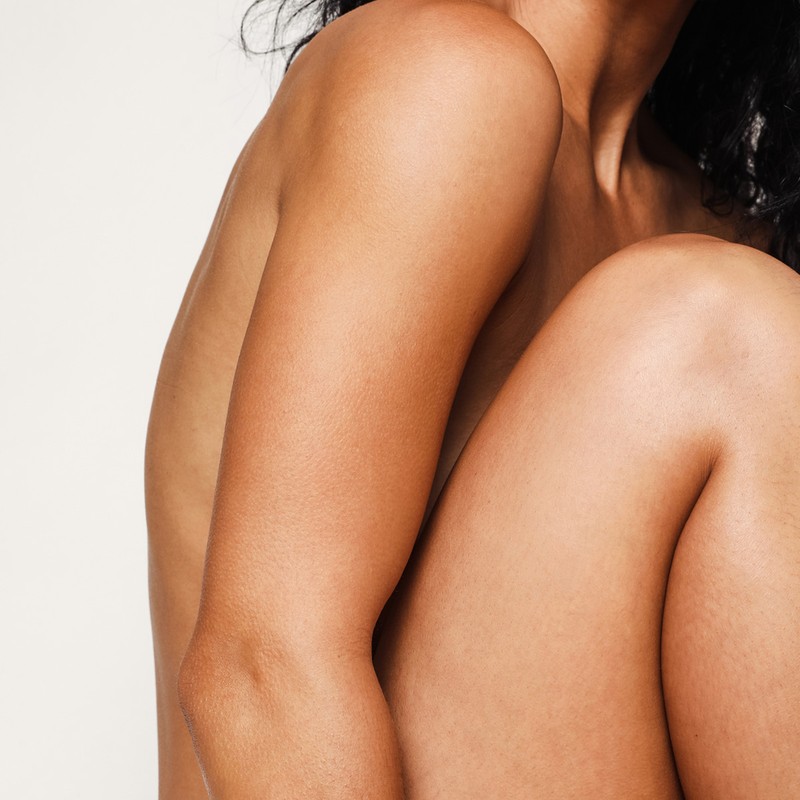Your Top Tanning Questions – Answered
What’s The Best Way To Stop Self-Tan From Fading?
Answer: “Moisturise your skin every single day using an aloe vera-based body lotion or butter. Avoid using any retinol-based lotions, or anything containing AHAs and BHAs – these will only encourage skin cell turnover, causing your tan to fade quicker. Also, drink plenty of water to keep your skin hydrated. I also always tell my clients before they travel to avoid drinking alcohol on the plane as the combination of pressure, mixed with alcohol causes severe drying in the skin, so the tan will fade much quicker. Likewise, chlorinated water in a swimming pool can strip a self-tan, so it’s a good idea to pack some tanning drops so you can up your colour again.” – Jules Von Help, Isle of Paradise founder
What’s The Best Self-Tan For Paler And Darker Skin Tones?
Answer: “It’s essential you work with your natural colouring, not against it. We’ve worked hard at Amanda Harrington to ignore the traditional ‘light, medium and dark’ categories that already exist on the market. Our tans are tonal, so they work with your natural complexion – you can, of course, layer up to go darker, but you’re always working with your own colouring. This is important because no matter how deep the colour is, it always looks true to you, and is therefore more flattering. In terms of choosing between different products, let your current routine guide you. If you’re a big moisturiser fan and want a slow release of colour, try a gradual tan. Or, if you want to streamline your make-up routine, try a facial tanner with added benefits.” – Amanda Harrington, InParlour & Amanda Harrington founder
“Self-tan should always look natural and my advice is to select your tan like you would your make-up. Light skin tones should opt for lighter solutions, medium to olive or more golden tones and darker skin tones should lean towards darker ranges. You can be savvy here – bear in mind that one coat of a medium-based tan will roughly equal two coats of a light tan and so on. It’s all about finding your shade, which can ultimately be a process of trial and error.” – Jules
Is There A Way To Stop Your Tan From Going Patchy Or Creasing?
Answer: “My mantra is ‘better by brush’ and, honestly, it’s a game-changer when it comes to minimising streaks and patchiness. First, apply your body tan using a professional, latex-free tanning glove. I prefer these to mitts as they don’t absorb too much product and are more hygienic. Then, to make sure your tan is streak-free and not settling into skin creases, follow up by using a big, fluffy body brush to really buff the colour into your skin. Pay particular attention to your knuckles, feet and around your ankle bones. I’ve been using brushes to tan and contour the body for 18 years – it’s brilliant to really hug the curves and contours of your body. It gives you optimum control, too.” – Amanda
Speaking Of Feet & Ankles – What Is The Easiest Way To Tan These Tricky Areas?
Answer: “Tan notoriously collects around areas like the feet, elbows and hands. All you need is a proper layer of hydration first, like our Ultra Balm. This acts as a barrier between your skin and the tan, to prevent streaks and patchiness. I also spent years developing a three-step method to reach those tricky areas. This includes tanning with gloves, followed by a good buff with a brush to ensure everything is even and smooth.” – Amanda
Is There A Way To Stop The Tan Transferring Onto Your Clothes?
Answer: “First, remove any excess tan left over from the application process. You can do this with a tan-removing formula, or by gently exfoliating. Focus on areas that will catch on clothes – like under your arms and around the neck. Failing this, use a tan that doesn’t contain a guide colour. Though these can be intimidating, they don’t stain, plus newer formulas have been designed to build more gradually. Also, try tanning two days before any event – this will help the colour settle into the skin and there will be less transfer onto clothes and other fabrics.” – Jules
How Do You Keep Your Face Tanned But Your Skin Clean?
Answer: “Carry on with your normal skincare routine – in fact, continuing to moisturise is crucial if you want to prolong your tan. The only things to avoid are serums or lotions with active ingredients. These will remove tan and dissolve it quickly. Post-moisturiser, use a tan mist – like our Day Dew – and let it absorb into the skin for a few minutes. Finish by applying an SPF mist on top, like Kate Somerville’s UncompliKated SPF Spray.” – Jules
Should You Use The Same Self-Tan On Your Body And Your Face?
Answer: “Sunless tanning products for the face are often developed with added skincare ingredients, so it’s best to stick to dedicated face formulas and dedicated body formulas. Our Illuminating Face Mist has added CQ1O, hyaluronic acid, collagen and vitamins A and E – all with added moisturising, firming benefits that you’d miss out on if you used a body tan on your face. Plus, the fine mist atomiser makes it easy to apply and blend for a fool-proof finish.” – Amanda
What Is The Right Amount Of Tan To Use On Your Face?
Answer: “It’s simple: two coats on the body, one on the face. Faces with too much self-tan look unnatural. Ensure your face is cleansed thoroughly – exfoliating will help develop a uniform skin tone. Splash your face with cold water to close the pores then use a toner and serum as normal. Another tip is to always brush your teeth before you apply any self-tan. Toothpaste collects by the mouth and the formula can completely dissolve tan.” – Jules
Does Using A Mitt Actually Make A Difference?
Answer: “Absolutely. A mitt protects the tan from transferring onto your hands and helps to evenly distribute the product. If you’re using tanning drops or waters, rub it in using your hands – just wash them with micellar water afterwards. As a rule, I always say use a mitt, or a brush. When it comes to fine-tuning the glow, a brush is essential. Knuckles, wrists, the neck, hairline and ears can all be perfected by using a kabuki brush to really blend the tan.” – Jules
What About When Fake Tan Goes Wrong – Can It Be Fixed?
Answer: “Prevention is always better than cure, so well moisturised skin is best for a seamless, longer-lasting glow. However, if you do hit some snags, a soak in a hot tub with a good-quality bath oil will help to slough uneven tan away. I recommend using a glycolic body scrub, too – it causes DHA (fake tan’s active ingredient) to separate on the skin, so it lifts away much quicker. If you want to remove tan from your face, try our Skin Face Advanced Glycolic Facial Pads, which remove misplaced colour fast.” – Amanda
What’s The Biggest Mistake People Make With Tanning?
Answer: “The biggest mistake people make when they fake tan is not spending enough time preparing their skin. We prep our face before applying make-up and our hair before styling it, so why wouldn’t you do the same before tanning? Good prep will give you the best, long-lasting colour. Start by exfoliating the skin and getting rid of any dead skin cells. Look to scrubs that contain key ingredients like glycolic. These will work to renew the skin and keep it looking and feeling softer. This can feel like a scary step if you have dry skin – often people think of exfoliators as ‘stripping the skin’ – but most formulas are packed with rejuvenating ingredients to replace any moisture loss. A prepped canvas – for face and body – will allow your colour to blend and absorb much better.” – Amanda
If You’re Getting Married, When Would You Advise Having A Tan Done?
“Two days is what I often recommend to let the tan settle. It’s also key you drink plenty of water prior to the tan. You want that end result to be glow-y and healthy looking. I also advocate moisturising afterwards with a plant-based squalane solution. This is a great way to keep your skin hydrated without risking the tan going patchy or breaking up. In the colder months, always moisturise eight hours prior to the tan, using a rich body butter to keep skin soft and supple – the Neal’s Yard Beauty Sleep Body Butter is a game-changer.” – Jules
Shop Our Favourite Tanning Products...








DISCLAIMER: We endeavour to always credit the correct original source of every image we use. If you think a credit may be incorrect, please contact us at info@sheerluxe.com.


